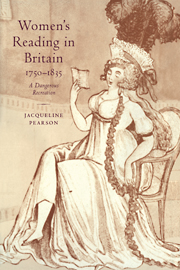Book contents
- Frontmatter
- Contents
- Preface
- Introduction
- 1 Pygmalionesses and the pencil under the petticoat: Richardson, Johnson and Byron
- 2 What should girls and women read?
- 3 The pleasures and perils of reading
- 4 Pleasures and perils of reading: some case histories
- 5 Where and how should women read?
- 6 Preparing for equality: class, gender, reading
- 7 A dangerous recreation: women and novel-reading
- Conclusion
- Notes
- Select bibliography
- Index
5 - Where and how should women read?
Published online by Cambridge University Press: 22 October 2009
- Frontmatter
- Contents
- Preface
- Introduction
- 1 Pygmalionesses and the pencil under the petticoat: Richardson, Johnson and Byron
- 2 What should girls and women read?
- 3 The pleasures and perils of reading
- 4 Pleasures and perils of reading: some case histories
- 5 Where and how should women read?
- 6 Preparing for equality: class, gender, reading
- 7 A dangerous recreation: women and novel-reading
- Conclusion
- Notes
- Select bibliography
- Index
Summary
It was not enough to read the right books: they had to be read in the right manner, the right company and the right places. In this chapter I deal with two revealing side-issues. First I examine libraries as gendered spaces and library-use as a gendered practice, for libraries offer a clear example of the consequences of perceived gender-differences in literacy and culture. The private library tended to be seen as a masculine space, even a symbol of male power and rationality, while the commercial library (the ‘circulating library’ which the literature so often denounces) was perceived, apparently in defiance of historical reality, as a femaledominated space representing both second-rate literature and transgressive sexuality. Libraries became a contested space.
Secondly I explore the different significances for women of reading silently and reading aloud. Roger Chartier finds this distinction one of the ‘fundamental oppositions’ of our culture, with the movement from reading aloud to reading silently a ‘macroscopic’ historical change. ‘[S]olitary’ and ‘silent’ reading was potentially rebellious or self-indulgent, while reading aloud formed the ‘bond and expression of social ties’ and was especially appropriate for women within domestic ideology.
THE REALM OF THE FATHER: PRIVATE LIBRARIES, GENDER AND POWER
By the mid eighteenth century the private library had become a ‘major feature of the rebuilding projects of noble families’. Darcy feels it a duty to future generations to maintain the fine library at Pemberley, and Sir Charles Grandison also has a remarkable library.
- Type
- Chapter
- Information
- Women's Reading in Britain, 1750–1835A Dangerous Recreation, pp. 152 - 175Publisher: Cambridge University PressPrint publication year: 1999



